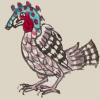totolin (Mdz7v)
This element for turkey [totol(in)] has been carved from the compound sign for the place name, Totolapan. It is just the head of the turkey, in profile, looking to the viewer's left. The bird's head is turquoise with red balls on top of it, red and turquoise stripes across the part above the beak, and a red area below the beak. The beak is white with purple edges.
Stephanie Wood
The head of the turkey hen in question looks much like the huexolotl (turkey) in another glyph (see below, right). Whether it is a female or a male, is open to question. This image of a "turkey red head" captures the turquoise and red color and the bumps, whereas the Wiktionary has a photo of a totolin that is less elaborate and colored somewhat differently from the glyphic one.
Stephanie Wood
c. 1541, but by 1553 at the latest
Stephanie Wood, Xitlali Torres
huehxolotl, vesulotl, uexolotl, turkeys, hens, turkey cocks, gallipavo, aves de corral, birds, guajolotes, fowl, ave, aves, pájaro, pájaros, pluma, plumas, animals, animales

turkey hen
Stephanie Wood
Codex Mendoza, folio 7 verso, https://digital.bodleian.ox.ac.uk/objects/2fea788e-2aa2-4f08-b6d9-648c00..., image 25, of 188.
The Bodleian Libraries, University of Oxford, hold the original manuscript, the MS. Arch. Selden. A. 1. This image is published here under the UK Creative Commons, “Attribution-NonCommercial-ShareAlike 3.0 License” (CC-BY-NC-SA 3.0).




